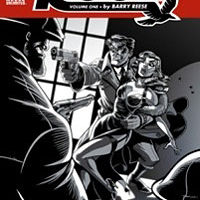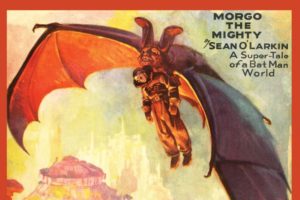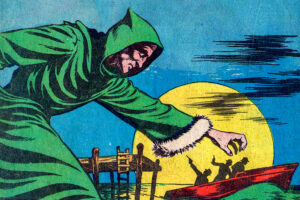Sometime back I did a review of the first Eric Trent collection from Steeger Books. Eric Trent was Donald Keyhoe’s next-to-last serial air-adventure character in Flying Aces, and among the last of his pulp fiction.
 More realistic than his previous character series (Richard Knight and Philip Strange) in that magazine, this short-lived series ran 13 stories from 1940-42 and basically replaced Philip Strange. Volume 1 reprinted the first six stories, and volume 2 reprints the final seven, both published by Steeger Books.
More realistic than his previous character series (Richard Knight and Philip Strange) in that magazine, this short-lived series ran 13 stories from 1940-42 and basically replaced Philip Strange. Volume 1 reprinted the first six stories, and volume 2 reprints the final seven, both published by Steeger Books.
Trent is an American who gets involved in Nazi plots and threats just before the U.S. entered World War II, and a bit after. He is not a formal agent at first, but more of a freelancer. He flies around and tries to sell the inventions of his associate, Mortimer Crabb. And they usually get involved with some plot or issue. As they aren’t agents, they have to extract themselves from the problem, including dealing with police and government agents who think they are part of the problem.
We don’t know too much about either man. Trent is described as dark-haired with a “well-trimmed” mustache. He used to be a magician’s assistant, and later we’re told he performed as the “Great Mysto,” and used various magic tricks like sleigh-of-hand stuff with people. Clearly a man of action, Trent is not shy about jumping into things. Crabb is from Vermont and your stereotypical reserved inventor. But he does lend a hand in the action as needed, though he will complain later. We know they have been working together for at least eight months before the first story.
And as this is an air-adventure series, there are always times when Trent and Mortimer are off in their plane fighting off the bad guys in some manner. That’s a given. At the beginning, Trent had a Douglas DC-3 in Europe, but after that flies an assortment of planes.
Interestingly, in one of these stories, the two confront an enemy that Richard Knight dealt with, and they mention meeting him. In another, they deal with the son of a major Philip Strange villain. Thus all three characters are in the same “universe.”
When we last left our friends, they were in the Americas, though in Alaska. This picks up in the next story, “Squadron of the Dead” which finds them in Washington, D.C. They get into the action when they witness an aviator getting shot down, and it turns out to be a top French ace thought dead during the invasion. He gives them a message to pass on to a top head in Naval Intelligence. From him, they learn of various strange events of planes from various allied nations attacking allied ships and planes. This may be tied to something called “The Invisible Empire” headed by a group called The Four Faces that Richard Knight also faced. And something is going on in Martinique. Can they put an end to things?
I see there is a Richard Knight story titled “Flight of the Dead” the month prior to this one. Does he also face the same foe? Does Knight succeed at ending the Four Faces?
In “Lure of the Liberators,” the boys have set up shop in Virginia near Washington when they hear of a couple of pilots from a previous adventure are found dead. Then they are attacked in their home by a Nazi agent, who escapes in a car, leaving behind an autogiro, which they make use of. Soon they are working with Gen. Busby from the fifth story to stop a group called the Purple Legion. They have a sinister plan they are working on.
With “Death Dives the Douglas,” the boys are again working with Gen. Busby to help him with a problem. And right off the bat, Trent stops a spy who is listening in on a top-secret meeting. Something is going on. There have been two planes, one Army and one Navy, that went off course and crashed. Are they connected? What is the cause? And does an upcoming training exercise play a part? Can Trent and Mortimer figure out what is causing this and put a stop to it in time?
Trent is called by Gen. Busby, and they head out in “Ryan Retribution,” but first have to get rid of a car following them, and then they capture someone who bailed out of a plane. Taking the man and the plane to an Army Base, they find the man has makeup to look like one of the men there! There is a plot going on with men disguised as others. Again, can Trent expose them all?
In “Death Flies Blind,” Trent and Mortimer are down in Texas, asked to look for a missing flight of training pilots who have disappeared in Mexico. Then they run into an Italian bomber there which is attacking what seems a model plane. Both planes crash, and a ranch house also catches on fire, but it seems set. Then a cowboy shows up in a small plane to help. Something is going on. Can they find the missing pilots and get to the bottom of things?
“Death Flies the Beam” is set after Pearl Harbor, and we find that both men have joined the Navy and are in Naval Intelligence, Trent as a commander and Crabbe as a lieutenant. Here they are working on a carrier, the Lextoga, in the South Pacific. Thus they finally are dealing with the Japanese after all the stories using Nazis.
In “On Haunted Wings,” the boys have been brought back to Washington to help plug a leak in Naval Intelligence. Trent is surprised to run into himself. They learn this is really Kurt von Zenden, the son of Philip Strange’s foe Karl von Zenden, the so-called “Man of the Thousand Faces,” Can they stop him?
It’s pretty sad there weren’t more stories. With the conclusion of this series, Keyhoe’s career as a pulp writer was also close to ending. He published his final Richard Knight story in the following issue of Flying Aces, and then the fourth and final of the Al “Click” Jarnaghan in the next. And that was it for Keyhoe in the pulps. I suspect that his returning to active duty during the war curtailed his fiction writing.
Now I really wish Steeger Books would work on completing the reprint of the Richard Knight series, and I wish that someone (Steeger? Age of Aces?) would reprint the short Al Jarnaghan series as well.



